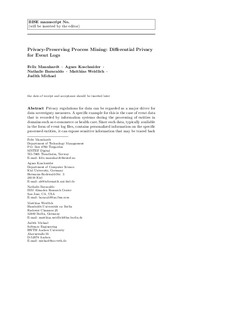| dc.contributor.author | Mannhardt, Felix | |
| dc.contributor.author | Koschmider, Agnes | |
| dc.contributor.author | Baracaldo, Nathalie | |
| dc.contributor.author | Weidlich, Matthias | |
| dc.contributor.author | Michael, Judith | |
| dc.date.accessioned | 2019-12-23T09:50:22Z | |
| dc.date.available | 2019-12-23T09:50:22Z | |
| dc.date.created | 2019-07-07T09:58:23Z | |
| dc.date.issued | 2019 | |
| dc.identifier.citation | Business & Information Systems Engineering. 2019, 61 (5), 595-614. | nb_NO |
| dc.identifier.issn | 1867-0202 | |
| dc.identifier.uri | http://hdl.handle.net/11250/2634393 | |
| dc.description | The final publication is available at Springer via http://dx.doi.org/10.1007/s12599-019-00613-3 | nb_NO |
| dc.description.abstract | Privacy regulations for data can be regarded as a major driver for data sovereignty measures. A specific example for this is the case of event data that is recorded by information systems during the processing of entities in domains such as e-commerce or health care. Since such data, typically available in the form of event log files, contains personalized information on the specific processed entities, it can expose sensitive information that may be traced back to individuals. In recent years, a plethora of methods have been developed to analyse event logs under the umbrella of process mining. However, the impact of privacy regulations on the technical design as well as the organizational application of process mining has been largely neglected. This paper set out to develop a protection model for event data privacy which applies the well-established notion of differential privacy. Starting from common assumptions about the event logs used in process mining, this paper presents potential privacy leakages and means to protect against them. The paper also shows at which stages of privacy leakages a protection model for event logs should be used. Relying on this understanding, the notion of differential privacy for process discovery methods is instantiated, i.e., algorithms that aim at the construction of a process model from an event log. The general feasibility of our approach is demonstrated by its application to two publicly available real-life events logs. | nb_NO |
| dc.language.iso | eng | nb_NO |
| dc.publisher | Springer | nb_NO |
| dc.relation.uri | https://rdcu.be/bOXut | |
| dc.subject | Data protection | nb_NO |
| dc.subject | Data sovereignty | nb_NO |
| dc.subject | Event logs | nb_NO |
| dc.subject | Differential privacy | nb_NO |
| dc.subject | Process mining | nb_NO |
| dc.title | Privacy-Preserving Process Mining: Differential Privacy for Event Logs | nb_NO |
| dc.type | Journal article | nb_NO |
| dc.type | Peer reviewed | nb_NO |
| dc.description.version | acceptedVersion | nb_NO |
| dc.source.pagenumber | 595-614 | nb_NO |
| dc.source.volume | 61 | nb_NO |
| dc.source.journal | Business & Information Systems Engineering | nb_NO |
| dc.source.issue | 5 | nb_NO |
| dc.identifier.doi | 10.1007/s12599-019-00613-3 | |
| dc.identifier.cristin | 1710488 | |
| cristin.unitcode | 7401,90,30,0 | |
| cristin.unitname | Teknologiledelse | |
| cristin.ispublished | true | |
| cristin.qualitycode | 1 | |
